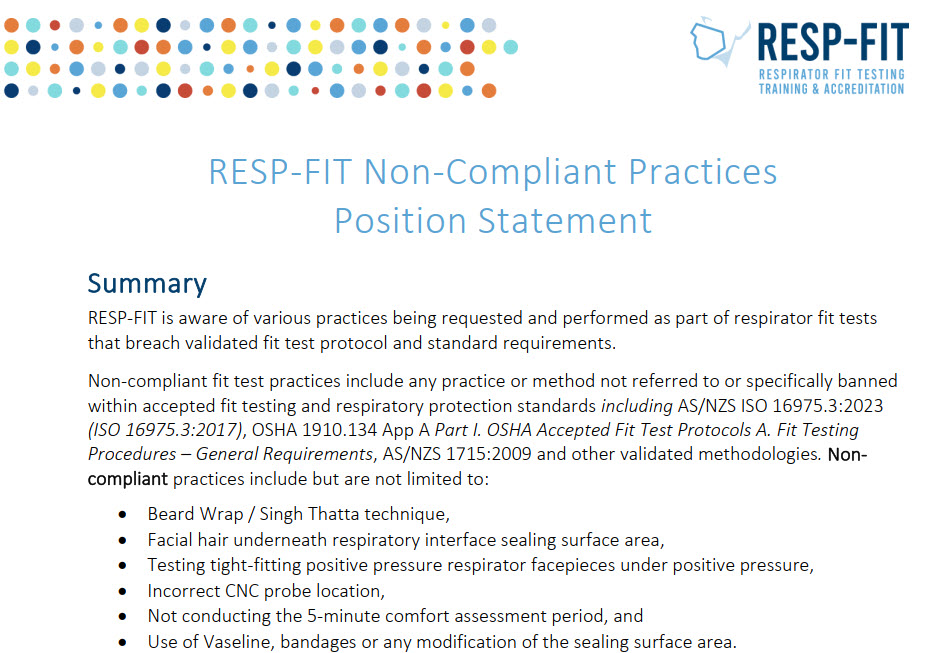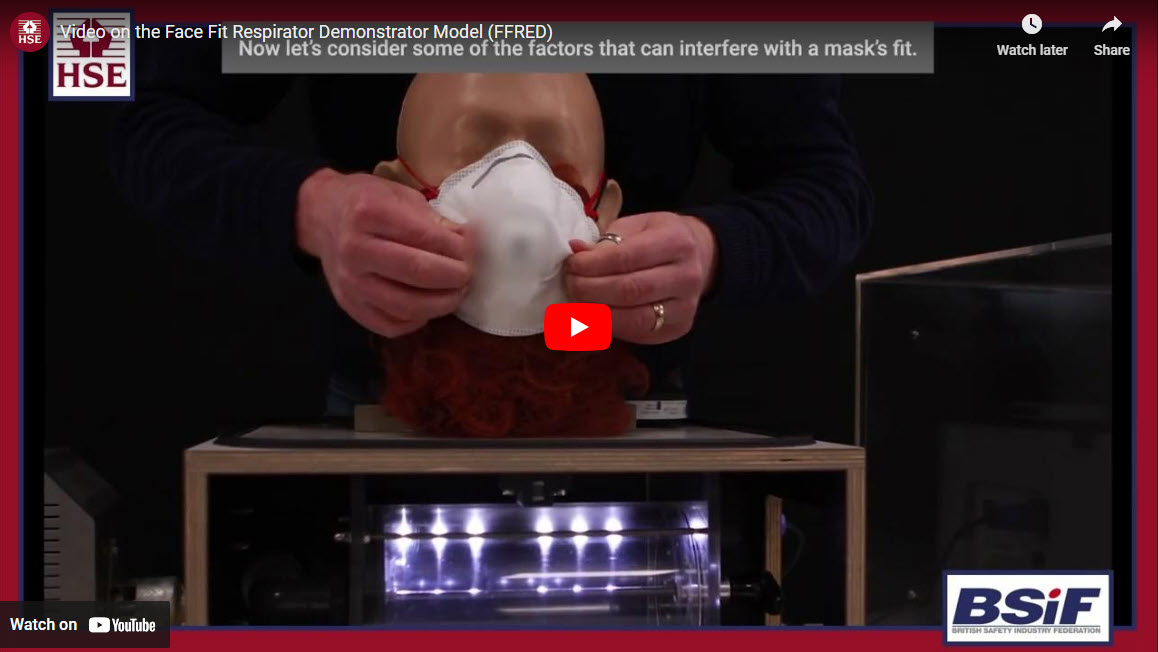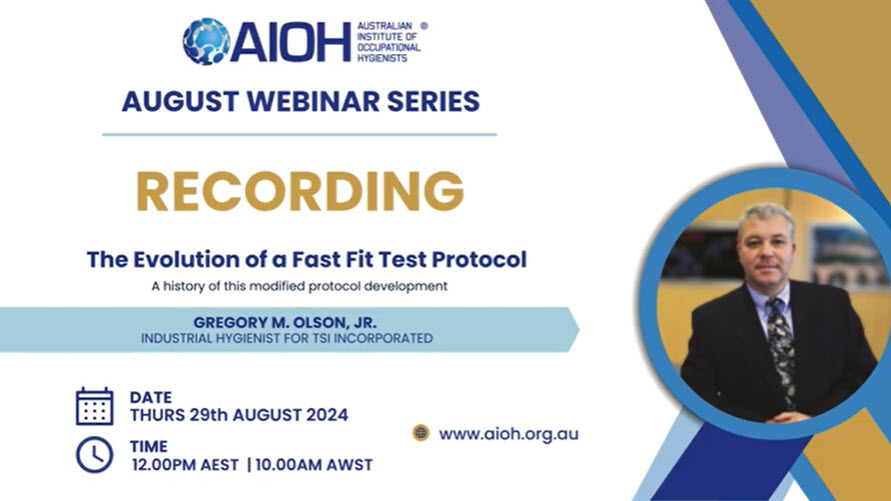RESP-FIT is aware of various practices being requested and performed as part of respirator fit tests that breach validated fit test protocol and standard requirements and have have put together a postion statement on “non-compliant practices”. The document (PDF) can be downloaded or is detailed below.
Summary
RESP-FIT is aware of various practices being requested and performed as part of respirator fit tests that breach validated fit test protocol and standard requirements.
Non-compliant fit test practices include any practice or method not referred to or specifically banned within accepted fit testing and respiratory protection standards including AS/NZS ISO 16975.3:2023 (ISO 16975.3:2017), OSHA 1910.134 App A Part I. OSHA Accepted Fit Test Protocols A. Fit Testing Procedures – General Requirements, AS/NZS 1715:2009 and other validated methodologies. Non-compliant practices include but are not limited to:
- Beard Wrap / Singh Thatta technique,
- Facial hair underneath respiratory interface sealing surface area,
- Testing tight-fitting positive pressure respirator facepieces under positive pressure,
- Incorrect CNC probe location,
- Not conducting the 5-minute comfort assessment period, and
- Use of Vaseline, bandages or any modification of the sealing surface area.
RESP-FIT requires all accredited fit testers to follow the accepted fit testing standards and protocols. Any test undertaken utilising non-compliant practices is not endorsed by RESP-FIT and should not be referred to as a fit test. Any RESP-FIT accreditation details, badges, ID, and/or AIOH branding must not be associated with these non-compliant practices. The use of RESP-FIT or AIOH branding on non-compliant practice documentation or communications may result in an individual’s accreditation being revoked.
Accredited fit testers are required to include a strong disclaimer with any non-compliant results or practices, indicating at a minimum:
- Any non-compliant practice undertaken (or requested to be performed) is a non-compliant practice and/or not recognised/considered as a “fit test” per fit testing standard definitions,
- It is not recognised by AIOH/RESP-FIT and is outside the scope of their accreditation/ profession,
- Any liability created by non-compliant practices is held by the person conducting a business or undertaking (PCBU)/employer requesting/accepting the test,
These disclaimers are also recommended for non-accredited fit testers.
It is recommended that fit testers receive and record written acknowledgement of this disclaimer from the organisation or individual requesting non-compliant practices.
Non-compliant practices undertaken by accredited fit testers and/or fit test service providers may not be recognised by their indemnity insurance coverage should an injury/claim arise. If they do choose to conduct non-compliant practices, we recommend that fit testers and fit test service providers discuss their specific insurance coverages with their insurance provider/s and speak with a commercial lawyer prior to engaging in non-compliant practices.
POSITION STATEMENT
RESP-FIT is aware of various practices being requested and performed as part of respirator fit tests that breach validated fit test protocol and standards requirements. Some of these non-compliant practices are listed below (but not limited to) and the corresponding requirements from the standard/protocol.
| Non-Compliant Practice | Protocol/Standard Requirement Reference |
|
Beard Wrap/ Singh Thatta technique/Vaseline/ bandage/seal modification
Refer to RESP-FIT position paper on beard wrap for further information. |
AS/NZS ISO 16975.3:2023 (ISO 16975.3:2017) 6.3.2 Foreign material: A fit test shall not be conducted if there is any foreign material or substance between the sealing surface of the respiratory interface and the face or neck. Examples include temple bars or straps for eyewear, gels and creams. OSHA 1910.134 App A Part I. OSHA Accepted Fit Test Protocols A. Fit Testing Procedures – General Requirements. 9. The test shall not be conducted if there is any hair growth between the skin and the facepiece sealing surface, such as stubble beard growth, beard, moustache, or sideburns which cross the respirator sealing surface. Any type of apparel which interferes with a satisfactory fit shall be altered or removed. |
| Facial hair underneath respiratory interface sealing surface area |
AS/NZS ISO 16975.3:2023 (ISO 16975.3:2017) 6.3.1 Facial hair: Skin contacting respiratory interface sealing surfaces shall be shaved within 24 h of testing, preferably within 12 h. A person shall not be fit tested if: a) hair comes between the sealing surface of the RI and the face or neck; and b) hair interferes with valves and/or RPD function. 4.4.3 Facial Fit 4.4.3.1 General Fit: …RPE employing a full facepiece or half facepiece shall not be used by males who are not clean shaven about the cheeks, neck and jaw. Half facepiece RPE of this type shall not be used by those with moustaches where there is any chance of hair coming between the facepiece and the skin. 8.3 Facial Hair in RPE Fitting: …individuals who have stubble (even a few days’ growth will cause excessive leakage of contaminant), a moustache, sideburns, or a beard which passes between the skin and the sealing surface should not wear a respirator which requires a facial seal. OSHA 1910.134 App A Part I. OSHA Accepted Fit Test Protocols A. Fit Testing Procedures – General Requirements. 9. The test shall not be conducted if there is any hair growth between the skin and the facepiece sealing surface, such as stubble beard growth, beard, moustache, or sideburns which cross the respirator sealing surface. Any type of apparel which interferes with a satisfactory fit shall be altered or removed. |
| Positive pressure tight fitting respirators fit tested under positive pressure e.g. with motor/power on |
AS/NZS ISO 16975.3:2023 (ISO 16975.3:2017) 6.5.1 General: All tight-fitting respiratory interfaces shall be fit tested in the negative-pressure mode regardless of the mode of operation in which the RPD is used. For positive-pressure breathable gas RPD and assisted RPD, this can be accomplished by: — temporarily converting the RI (Respiratory Interface) into a negative-pressure RPD by using an appropriate adapter and filters; or — using a negative-pressure RPD with an identical RI sealing surface.
|
| 5-minute comfort assessment period was not undertaken |
AS/NZS ISO 16975.3:2023 (ISO 16975.3:2017) 6.6.2 Comfort Assessment Period: Initial RPD wearers and anyone who changes the model or brand of RPD shall wear the RPD for a comfort-assessment period of approximately five minutes immediately prior to the fit test. OSHA 1910.134 App A Part I. OSHA Accepted Fit Test Protocols A. Fit Testing Procedures – General Requirements. 5. The more acceptable facepieces are noted in case the one selected proves unacceptable; the most comfortable mask is donned and worn at least five minutes to assess comfort. |
| Incorrect Probe/Sampling Location |
AS/NZS ISO 16975.3:2023 (ISO 16975.3:2017) 6.5.4 Sampling for Aerosol Systems In-RI aerosol sampling devices shall be designed and used such that the sample is drawn at a point close to the face, midway between the nose and mouth. The sample probe should extend into the RPD cavity, but not close enough to be blocked by the face. The in-RI (respiratory interface) sampling point shall not be isolated from the nose or mouth by a physical partition. For example, if a nose cup is used on a full facepiece, the sample point shall be inside the nose cup. Care shall be taken to ensure that sample tubing is not extended beyond that which is necessary to take a sample from the breathing zone.
OSHA 1910.134 App A Part I. OSHA Accepted Fit Test Protocols C. Quantitative (QNFT) Protocols 6. The in-mask sampling device (probe) shall be designed and used so that the air sample is drawn from the breathing zone of the test subject, midway between the nose and mouth |
Where these and other non-compliant practices have been performed, the tests and outcomes shall be considered as non-compliant.
Any non-compliant practice that has been accepted, requested, or recommended in a workplace by a PCBU, by a respirator manufacturer or any other party CANNOT therefore be referred to as a “fit test” or “fit testing” as it does not meet the definition requirement of a fit test per the below-referenced standards/protocols. Those parties also hold any liabilities associated with their accepted, requested and/or recommended non-compliant practices.
| Standard/Protocol | Definition |
|
AS/NZS ISO 16975.3:2023 (ISO 16975.3:2017)
|
3.2 Fit test use of a challenge agent and specific protocol to qualitatively or quantitatively determine the effectiveness of the seal between the wearer’s face and respiratory interface with a specific make, model, and size of an RPD |
| AS/NZS 1715:2009 |
1.5.28 Facial fit test A validated method of matching a respirator to an individual. |
| OSHA 1910.134 | Fit test means the use of a protocol to qualitatively or quantitatively evaluate the fit of a respirator on an individual. |
A validated fit test method (and future methods) is one that has met the requirements of Annex C of AS/NZS ISO 16975.3 which references ANSI Z88.10 method as the internationally known criteria for evaluating new fit test methods. Any PCBU, Industry or respirator manufacturer validation of a process that does not meet the criteria Annex C of AS/NZS ISO 16975.3 / ANZS Z88.10 requirement CANNOT not be referred to as a “fit test” as it does meet the criteria above.
The use of fit test equipment, terminology, and references with non-compliant practices and/or non-validated protocols does not make the process compliant. This is the heart of much of the confusion/misunderstanding in industry as non-compliant practices will appear as a compliant fit test for workplaces and workers not familiar with ALL the fit testing protocol requirements and definitions. Hence the importance of competent person fit testers and workplaces/workers being provided correct, consistent, and reliable information.
It is important to highlight that fit testers and fit test service providers are also a PCBU (in addition to those fit testing within a PCBU) that also have a legal responsibility to those they are fit testing under the Model WHS Act Section 19 Primary Duty of Care Subsection 1b and 3c (but not limited to) and may be seen as not following safe systems of work and liable to the penalties under the Act.
Non-compliant practices undertaken by fit testers, fit test service providers, PCBUs or employers, may not be recognised by their indemnity insurance coverage. If they do conduct, accept or recommend non-compliant practices, we strongly recommend that fit testers, fit test service providers, PCBUs or employers discuss their specific insurance coverages with their insurance provider/s.
Fit testers/service providers operating outside a selected fit test protocol, may be deemed liable or at fault, with possible exposure to fines or other penalties and litigation.
Accredited Fit Testers and Non-Compliant Practices
RESP-FIT requires all accredited fit testers to follow compliant practices, including all requirements of the chosen fit test protocol/standard.
Where an Accredited Fit Tester is being requested to conduct a non-compliant practice/s, they must communicate to the requesting party and that it is a non-compliant practice and is not a “fit test” or “fit testing” per the standards/protocol definition and requirements. The party accepting, requesting or recommending non-compliant practices needs to understand they are responsible for liabilities that may result from non-compliant practices being undertaken.
Any accredited fit tester performing these non-compliant practices shall not use the term “fit test” or “fit testing” in reference to non-compliant practices and are deemed to be operating outside the scope of their accreditation/profession. RESP-FIT accreditation details, badges, ID, and/or AIOH branding must not be associated with or inferred from any non-compliant practices as a “fit test”, “fit testing”, “compliant fit test” or similar compliant terminology. Any association in this manner may result in an accreditation being revoked.
It is required that accredited fit testers (and recommended for non-accredited fit testers) provide a statement/disclaimer for use in communications and on reports clearly stating that any non-compliant practice undertaken (or requested to be performed) is a non-compliant practice, is not recognised as a “fit test” per fit testing standard definitions, is not recognised by AIOH/RESP-FIT, is outside the scope of their accreditation (if accredited)/profession, and any liabilities/outcomes from the non-compliant practices are held by them (whoever is accepting, requesting or recommending non-compliant practices). It is also recommended that fit testers record written acknowledgement of this statement/disclaimer for insurance purposes, workers compensation case evidence and for records should a PCBU/employer wish to proceed following acknowledgment of this disclaimer/statement.
As stated earlier in this document, non-compliant practices undertaken by accredited fit testers and/or fit test service providers may not be recognised by their indemnity insurance coverage should a claim arise. If they do choose to conduct non-compliant practices, we recommend that fit testers and fit test service providers discuss their specific insurance coverages with their insurance provider/s and speak with a commercial lawyer prior to engaging in non-compliant practices.
If you have any questions, please get in touch with RESP-FIT via email at respfit@aioh.org.au
Prepared by the RESP-FIT Board July 2024:
Mark Reggers, Melanie Cox, Michael Eva, Dr Julia Norris, Dr Peter McGarry, Julie Moore, Heidi Scott, Sebastian Rasche and Jane Whitelaw



